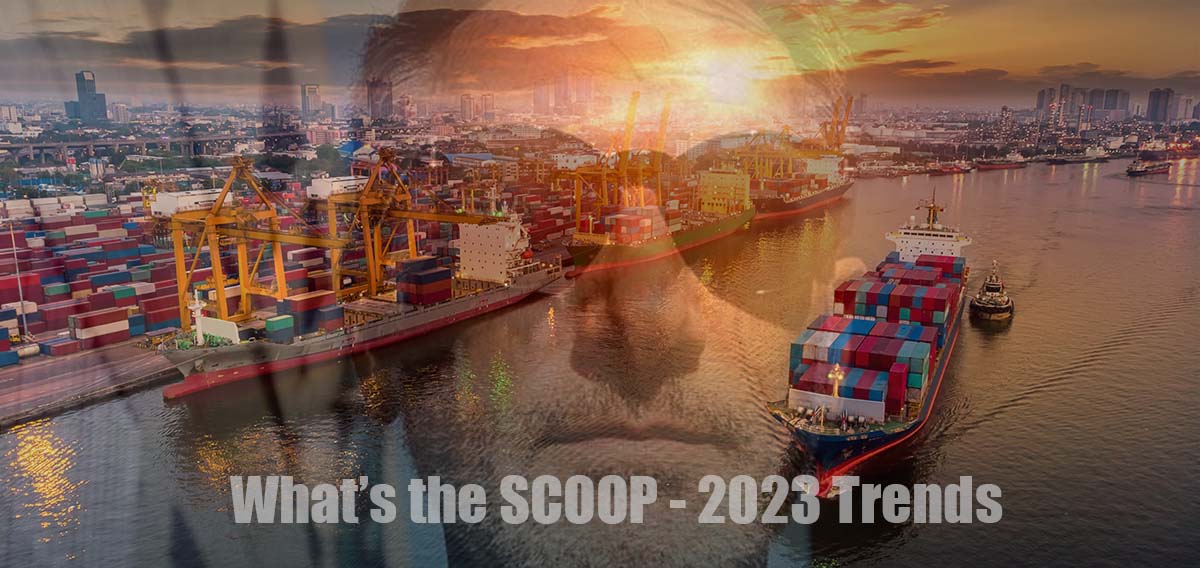What’s the SCOOP – 2023 Trends – part one

By Philip Spagnoli Stoten
It’s been a good year for the EMS industry in general, and with better component availability it would have been even better. But how is everyone in the industry feeling about 2023? I reached out to around 50 CEOs and many responses are in. Take a look at what those running EMS companies and those the companies that supply them as well as a smattering of what consultants, experts and economists think.
We’ll be serializing the thoughts and musing of the industry’s great and good over the coming week and wrapping that series up with an e-book in January. I’ve started interviewing some of those that contributed and you can watch those interviews in the EMS@C-Level youtube playlist, or listen to the EMS@C-Level podcast on buzzsprout or wherever you get your podcast. If you have an opinion and want to share it, write to me in less than 400 words and we can add it to the mix. If you don’t have my email address hit me up on LinkedIn.
 Bruno Racault, President & CEO, ALL Circuits
Bruno Racault, President & CEO, ALL Circuits
2022 was a curious year for us and for the entire industry. Demand was strong, but supply chain shortages reduced our ability to ship, creating a larger backlog than we would like, along with increased inventory and WIP. And that means greater demands on cash as working capital increases.
In the meantime, our order-book continued to grow thanks to a desire among OEMs to source their electronics closer to home and to reduce dependence on Asia, and in particular China. To meet demand from our customers in the automotive space, we opened a substantial extension to our MSL facility. Meanwhile we won substantial orders from French companies for IoT and educational products.
I am optimistic about the coming year, but I remain concerned about the challenges in getting the parts needed to complete products. It would be a pity to see shortages continuing to slow shipments. What’s more, we see rising costs due to inflation, particularly in the cost of energy. The result is that even with the measures we have taken to continue to become more efficient, price rises for our customers are unavoidable.
On the demand side, news is good. We see our markets as resilient thanks to the increasing use of electronics in cars, particularly EVs, and demand for IoT products in numerous sectors, like education, smart homes and medical. I believe that the pervasive nature of technology, combined with the ongoing European manufacturing renaissance, will serve us well in 2023 and beyond. We have bold growth targets for the coming years and expect to meet them.
Labor shortages remain a challenge everywhere, but we believe our leadership in digital transformation and the use of adaptable automation will help us to continue to grow without growing our headcount too much. On his recent European tour, EMSNOW Publisher, Eric Miscoll, described our facility as the most advanced he’d seen in terms of automation. We agree.
 Joel Scutchfield, General Manager of SMT Business Operations & Director of Sales, Koh Young America, Inc.
Joel Scutchfield, General Manager of SMT Business Operations & Director of Sales, Koh Young America, Inc.
2022 was a special year for Koh Young, we celebrated our 20-year anniversary and installed our 20,000th inspection machine. And in the Americas alone, we installed nearly 500 systems.
While 2022 was a banner year, we look to 2023 with guarded enthusiasm. Here’s why.
- Many of our customers have shared that they have big backlogs and orders to carry them through 2023. Order cancellations and continued part shortages were their main concerns at this point. While many are waiting for demand to soften, few are seeing it as of yet.
- Some reshoring plans have been tempered by the inability to find good people in both the US and Mexico. Most of the larger EMS players agree that they need to introduce more automation into post SMT line assembly, to offset labor cost (in US) and the talent shortage in both locations. It would be a pity to see these talent shortages slow this regionalization trend.
At Koh Young, we feel like we are aligned with the right kind of customers to be able to manage any downturn better than many others. Customers in EV, 5G, Cloud, Solar, Mil Aero, Advanced Packaging, and those that put a priority on Smart Factory realization, continue to explore and engage with the solutions we provide. And our newer innovations in pre-reflow AOI and dispensed material inspection are growing in popularity and demand. The industry recognizes our ability and passion to partner with them to produce better products more efficiently, and we expect that to continue.
 Carl Hung, President & CEO of Season Group
Carl Hung, President & CEO of Season Group
With 2023 is around the corner, optimism toward supply chain easing is growing. But I expect this crunch to persist into the new year. What’s more, inflation is surging and expected to peak in the first quarter of the year. With all that said, questionable supply capacity is likely to again result in a supply shortage. And add-on a downtrend in the economy, with subsequent decelerating demand and it’s a less than cheerful picture. There are rightly concerns about consumer demand, due to a loss of purchasing power given the slower rate of salary increase and higher inflation.
It’s also important to consider the US ban on Chinese defense and tech companies from October 6th, steering the path quite frankly, to dismantle global supply chains, contributing to higher inflation and slower growth. True, this blanket ban brings opportunities for the emergence of lower-tech chips produced locally in China as alternatives, but the immediate difficulties and extension of the supply chain issues are ongoing. This will affect the overall industry.
To address these continuing supply chain issues we at Season Group are approaching it in two ways. One is product redesign and the second is taking a multi-region approach to the supply chain. Product redesigning comes from our value analysis and value engineering (VAVE) practices. With product redesign using cost-effective and available best alternative parts, we’re able to create a positive service and a positive outcome for our customers.
 Mike Konrad, Founder & CEO of Aqueous Technologies and Podcast Host
Mike Konrad, Founder & CEO of Aqueous Technologies and Podcast Host
One of the most optimistic things about 2023 is that it’s not 2020 or 2021! While epidemiologists may take exception, much of society has witnessed the return to normalcy, or at least a new normalcy.
As the pandemic seems to either be subsiding or our sensitivity to it has calcified, new threats loom on the economic front and world stage. Inflation, rising interest rates, and the threat of recession are potential 2023 buzzkills.
I founded my company thirty years ago and have witnessed several recessions. The current threat of a recession seems considerably different than ones of the past. While economic data suggests a likely recession, the simultaneous labor and parts shortages seem counterintuitive to a slowing economy.
The real question that causes me to ponder is the following. Will the rise of IoT and IIoT along with the rapid electrification of automobiles and the required investments in EV infrastructure provide adequate cover for the EMS industry? Time will tell.
As an entrepreneur, I suffer from perpetual optimism. In my world, there is neither a glass half full nor half empty, only an opportunity to fill it. So, with that said, I believe there will be a mild recession that will affect much of our country’s business sectors. I believe the EMS industry, however, will escape the worst of the economic contraction due to the unprecedented expansion of technology and the consumer’s insatiable appetite for the marvels our industry produces.
With the aforementioned economic factors in play, the current war in Europe, and the potential conflict between China and Taiwan, there is much that can keep us all up at night. In spite of this, I remain confident that 2023 will prove to be a mostly successful year for our industry.
 BH, CEO, Flexi Versa
BH, CEO, Flexi Versa
Geopolitics has been a huge issue in the supply chain this year and I am expecting that to continue into 2023 with more concerns over the war in Europe and China’s position on Taiwan. For companies like us, this means we are seeing an increase in demand to leverage the value of Asia without an over dependence on China.
As I wrote in a recent article published in EMSNOW, I expect us to see a second wave of growth for the Asian Tigers and Tiger Cubs in the coming years. These countries have a huge amount of experience and talent to offer, as well as a mature supply chain. It will be interesting to see what role India and the rest of South East Asia plays in the coming twelve months, with many tech companies committing to shifting part of their manufacturing footprint there.
We have suffered less than most from supply chain issues this year, due to highly engaged relationships between our supply chain teams and our customers as well as due to the vertical integration within our company. Our plethora of PCBAs, components, plastics and woodworking continue to serve our customers integrated needs.
Of course, economic disruption remains a concern everywhere. I suspect this will result in softening demand in certain sectors, particularly those that depend on consumer spending. We are lucky that we have a diverse customer base and have been growing this year in sectors like medical devices, IoT and industrials Clearly some sectors will do better than others in 2023, but the total electronics industry seems to continue to grow year after year as technology finds its way into more and more products.
 Akhil Oltikar, Co-founder & CEO, Omnics
Akhil Oltikar, Co-founder & CEO, Omnics
Here are my three big trends for 2023:
Right Shoring: Companies that have offshored their manufacturing and supply chains are now looking at re-shoring, on-shoring, near-shoring or friend-shoring. Even before the pandemic, there had been a trend of companies trying to diversify their supply chain from China to other countries, due to trade wars and tariffs. I expect this trend will now accelerate. However, no region or country is self-sufficient and global trade is interdependent. Hence ‘Right Shoring’ is a strategy companies need to adopt based on their go-to market and product strategy.
Supply Chain Technology: Supply chain visibility is still tough but the challenges that we face today are more about what to do with the data and information at hand. It’s no longer about data acquisition. It’s about ‘data reaction’ and this will be an even bigger trend going into 2023. Companies are lacking tools to manage the massive data deluge as well as solutions for planning, decision-support and execution. Investment in technology and talent in supply chain planning will continue to grow. Going forward, there will be more emphasis on rapid what-if analysis, scenario planning and unified supply chain data models. Additionally, robotic process automation (RPA) of supply chain management processes will play a big role, allowing the supply chain team to focus on value-add activities vs. repetitive, non-value add tasks.
Digital Transformation Continues: Digitization is driving exponential increase in data size and global supply chains need faster and smarter answers. Every action and reaction in supply chain operations generates data. As companies digitize this data it is imperative to implement tools to extract, analyze and share this data to unlock its potential across your supply chain. Digital transformation is a tall order. As digitizing supply chains becomes easier than ever, managing them is becoming harder. Companies need experienced supply chain professionals to work alongside those with the ambition of upcoming digital talent.











